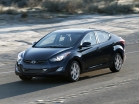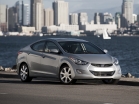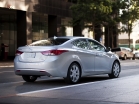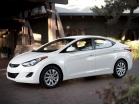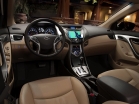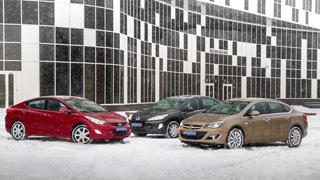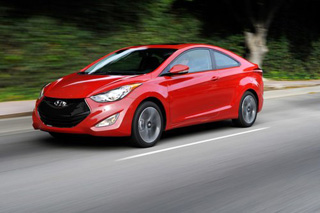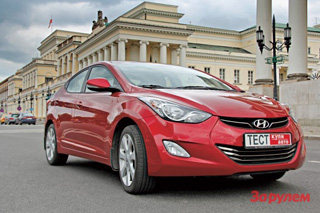Hyundai Elantra sedan test drive since 2010 sedan
Hyundai Elantra test drive: as a guest
Russian sales of the latest generation began only a year and a half after the premiere. By this moment, the novelty has settled tightly on the market of South Korea and escaped to the leaders in the United States. And what about Russia?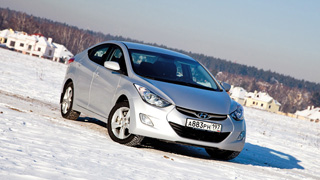
It's no secret that the main trump card of the Hyundai model range in Russia is the current Slaris bestseller. It was on its promotion and production at the plant in St. Petersburg that Hyundai threw all free resources. With the new Elantra, the situation is exactly the opposite. First of all, the Korean plant in Ulsan works to ensure the domestic market and the USA, and only then the remains are distributed to other countries, including Russia. Last year, the Russian quota amounted to only about 2 thousand cars, in 2012 they promised to bring about 18 thousand already.
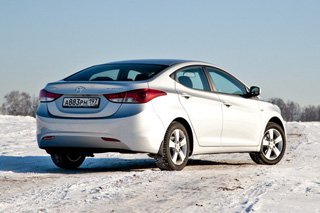
Hyundai Elantra's debut in the Russian market took place only after a year and a half, after the US and Korea markets. The car shares one platform with the new generation of the Hyundai i30. True, like Kia Cerato in Elantra, the rear independent suspension i30 was replaced by a cheaper beam.
Now the basic cost of the Hyundai Elantra 1.6 with manual transmission, air conditioning, two pillows, heated and front electric glasses begins at 694,900 rubles, a car with a machine will cost at least 816 thousand rubles, and the price of a top version of SPORT with a 1.8-liter motor is close I got to the mark of 900,000 rubles. For comparison, the cheapest Ford Focus with air conditioning costs 561,800 rubles, and the price tag for the recently updated Mazda3 starts from a mark of 625,000 rubles.
However, Hyundai Elantra looks stylish and fresh. The bumper smiling at the front wings, the front optics, belted with powerful sides of the sides, stretched rear lights and heavily littered racks, this Asian outfit is clearly to her face. Outside, the Elantra is more beautiful than mass solarium and elegant heavy sonata. The real golden middle of the technogenic South Korean fashion.
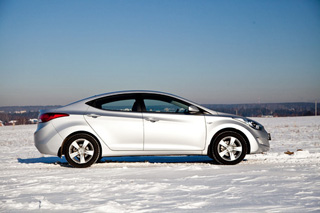
A swift silhouette, beautiful optics, smooth contours around the arches - the design of the novelty turned out to be successful in this Hyundai discipline, perhaps one of the leaders in the classroom.
The bright style continued in the cabin. The interior looks relevant and not boring. The top of the front panel and doors are made of soft plastic, the profile of the seats is not bad, the control ranges are sufficient, the front armrest has adjustment in length, and the steering wheel is not only beautiful, but also convenient. In addition, the floor pedal of gas and good readability of the dashboard can be brought into the piggy bank.
However, there were no miscalculations. The poisonous blue backlight of the central console strains the eyes in the dark, low the central air ducts blow directly into the knees and do not close, the silver-plated plastic gives the low cost, the force on the buttons and the twists of the air is fuzzy, and when the fan is turned on, the air conditioner lights automatically light up, which has to be disconnected after each launch engine.

The interior of Elantra is beautiful and elegant. Part of the front panel and casing of the doors are made of soft plastic. With ergonomics, too, everything is in order, and there is enough free space.
But behind the spaciousness! Here, even tall passengers will sit down without problems. Moreover, the three of the central tunnel is possible. In terms of the volume of the trunk, Hyundai Elantra also did not pump up 485 liters of useful volume and a full -size reserve. But, as in the case of the salon, in general, a good impression was spoiled in the details in detail: the opening of the trunk lids are too small for a large -sized cargo, with folded rear seats a large step forms on the floor, and there is no handle for closing on the inner surface of the lid of the trunk!
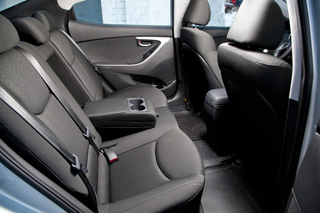
By the number of space for the rear passengers, Elantra will put any classmate on the shoulder blades. Passengers of any complexion will be freely shedding from behind.
The 1.6-liter motor is similar to the Hyundai Solaris unit, but due to improvements, it develops 132 hp. The test Elantra was equipped with 6-speed mechanics, but a 6-speed automatic transmission is available for surcharge. By the way, for their automatic transmission in Hyundai they will forgive no less than 70 thousand rubles. This is 6 thousand rubles more than the Volkswagen 7-speed DSG transmission with two clutches, and twice as much as the Ford PowerShift box.
The motor is good. After the tachometer arrow will pass the mark of 2.5 thousand revolutions, the unit goes into the working area and takes it very cheerfully up to the cut -off. The mechanical transmission works collected, the moves of the lever, although they are too big, but the transfers are easily and clearly.

The 132-horsepower 1.6-liter engine pleases with excellent thrust at medium and high speeds. 6-speed mechanics are distinguished by clear, but slightly stretched moves. Hyundai steam well and has a dense suspension. The main complaints about behavior in the rut and sound insulation.
At low speed, Hyundai pleases intelligible and clear reactions. With the speed of speed, the steering wheel is poured with a pleasant effort, and the information content did not disappoint. The only claim to the steering is non -linear reverse action: the car has already turned, it is time to return the wheels to a straightforward position, and the electric power capture rests, continuing to simulate the effort at the reverse move.
While the road is even, the Korean sedan behaves stably, goes strictly in a straight line, without deviating from a given course. But as soon as rollerity appears, the feed with a beam in the rear suspension begins to walk in the transverse direction, forcing to lose speed. The brakes are not bad. Despite the fact that the pedal force increases a little not linearly, efficiency is at a height. And the main scourge of Hyundai Elantra is a weak sound insulation. In the cabin, the noise from tires, and aerodynamic twisters, and the rumble of the motor are clearly heard, it is worth raising the momentum above the average.
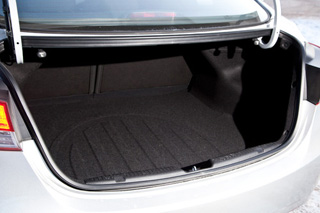
The trunk is roomy - 485 liters of free space. However, there are also disadvantages - a narrow opening and the absence of an internal handle for closing.
I liked the suspension. Moderately comfortable and tough, it copes well with medium and large irregularities, while noticing small joints and cracks. On the Hyundai Elantra turn, he holds well as well as a given trajectory with moderate roll. In the limit, a typical front -wheel drive insufficient rotation and the desire to straighten the trajectory, which smoothly flows into a controlled skid for discharge of gas.
It is unlikely that the Hyundai Elantra will occupy a leading position in sales ratings on the Russian market, even if Hyundai increases quotas. Now the success of the model in B- and C-classes directly depends on the localization of production in Russia. It is localization that allows car manufacturers to conduct a flexible pricing policy, which has already been proven by many models, including Hyundai Solaris, VW Polo Sedan and others.
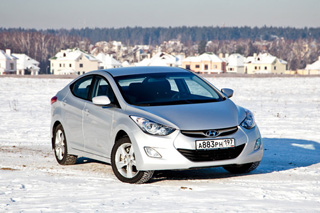
For Russian dealers, the price of Hyundai Elantra starts from a mark of 694,000 rubles. The test car in the average configuration of Comfort with a manual transmission costs from 779,000. The cheapest sedan with automatic transmission is offered from 816,000 rubles, and the top Elantra 1.8 Sport is estimated at 899,000 rubles.
In the USA, Hyundai Elantra is very popular. Still, a beautiful spacious car in a good configuration with an automaton for only $ 17,595 (527,000 rubles). In Russia, only the basic price starts from the mark of 694,000 rubles, which, of course, by our standards is a little expensive. Therefore, the Russian market will most likely accept the new Hyundai Elantra, but only as a guest.
Ruslan Galimov
Source: Carclub.ru

